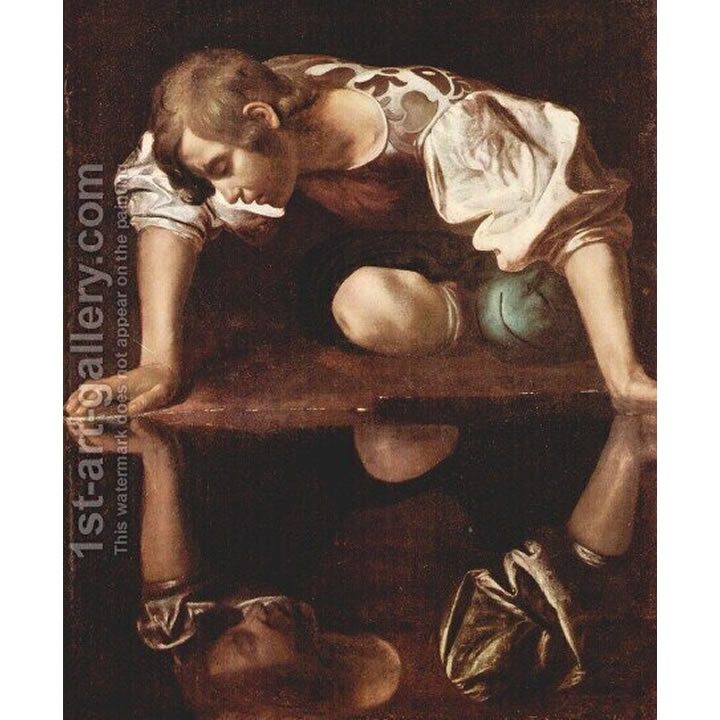From myths and mythologies to Greek Goddess paintings, from Renaissance tales to Surrealist masters, history has been nothing but a myriad. Greek mythologies and Renaissance paintings have always attracted artists like a moth to a flame. Painters weren’t just satisfied with hearing the intriguing Greek myths; they also had to manifest them into paintings.
The tragic love of Persephone & Hades and the myth of Medusa have been documented into poems and painted onto canvases. There are thousands of versions of the creation and destruction of the world, all originating from Greek myths.
These Greek and Roman myths have been retold and reinterpreted throughout the centuries. Let’s look at some of the best nerve-wracking and enjoyable Greek myths:

Caravaggio by Narcissus

Famous mainly from Ovid’s Metamorphosis 3.5, ‘Narcissus’ by Italian artist Michelangelo Merisi da Caravaggio depicts the Greek myth of a young man and his ruinous story of self-love. After a long, tiring hunting day, Narcissus stops before a river to quench his thirst and leans over the water. Not knowing that he is staring at his beautiful reflection, he falls in love with his mirrored image in the stream.
As soon as he tries to kiss the alluring reflection, it contorts and vanishes. Waiting for the man in the water to love him back, he died of yearning and longing. Upon his death, he transformed into a white and gold flower bearing the same name.
The painting illustrates a pitch-black background and equally dark water in painting, with Narcissus and his reflection the only center of attention. There is a sad look in his eyes that gives the masterpiece a melancholic vibe. Only a few are aware that the word ‘narcissist’ is based on this self-obsessed bloke.
Pandora by Odilon Redon

This famous Greek mythology is familiar to every child and adult, no matter the year. Pandora, the first woman on Earth, was sent by Zeus to seek revenge on Prometheus. Zeus gave her a box and warned her never to open it when Pandora was sent to the utopian world of Earth,
Unable to resist the temptation, though, she opened the box and released the evil that will haunt humanity forever, namely, death, old age, and plague. Painted in 1914, just as the horrors of World War I started, Odilon is believed to remark on the theme of destruction and chaos, unleashed by a simple box.
Odilon chose to portray Pandora as the epitome of beauty, naked and surrounded by an equally beautiful garden of flowers. However, Pandora’s attention is directed solely towards the box, and she seems ignorant to the golden age that she would soon be putting an end to.
Allegory of Fertility by Jacques Jordaens

Painted in 1623 by Jacques Jordaens, ‘Allegory of Fertility’ depicts the vital fertility of nature, with fruits, animals, humans, and Gods huddled together. The grapes on the left represent the richness of nature, with the cornucopia on the far right depicting Ovid’s Metamorphosis. A life-size nude figure is painted from behind, surrounded by her female companions and satyrs.
The colors used in this painting are glowing and bright, with shimmering shadows and lights bringing out the life of the stilled images. There is a sense of harmony and carnal exuberance in Jordaens’s paintings, making them even more prolific and luxuriant.
Leda and the Swan by Peter Paul Rubens

Women being seduced by divinities was a favorite topic in Greek mythologies. Its problematic and disturbing nature only started to strike people in later centuries. In his painting ‘Leda and the Swan,’ Rubens shows a swan, disguised by the God Zeus, draped around the nude body of Leda, the queen of Sparta.
Leda then gave birth to Polydeuces and Helen, the children of Zeus. The story takes an even more intriguing turn when Helen runs off from Zeus and is said to be abducted by Paris, the Trojan Prince. This later instigated the Trojan War, another legendary Greek mythology tale.
Rubens has chosen dark shades to paint the background, while the body of Leda is illustrated with contrast shades of light hues. The swan’s body is depicted in silver and white while his blue feathers sway gorgeously.
The Wine of Circe by Edward Burne-Jones

Considered as the daughter of the Son-God in Greek mythology, Circe is a powerful and enticing woman who turned men into animals. In the ‘Wine of the Circe,’ Jones portrays Circe as she measures out the wine that will transform her loyal lovers into tamed animals.
Two panthers are shown at her feet, who look at her in awe and devotion. A ship is painted outside the window, signaling that more sailors will fall prey to her beguiling trap. This Renaissance artwork is also a jab at the women’s supposedly controlling and charming nature. Dante Gabriel Rossetti even wrote a famous sonnet inspired by this painting.
Conclusion
The engaging and fascinating tales of Greek mythology will always keep its listeners enthralled. Many renowned Greek Goddess Paintings have a hub at the 1st Art Gallery, which is the world’s largest supplier; of made-to-order oil paintings! So go and explore these paintings and have them in your home as an excuse to show off your knowledge about the Greek and Roman myths.

